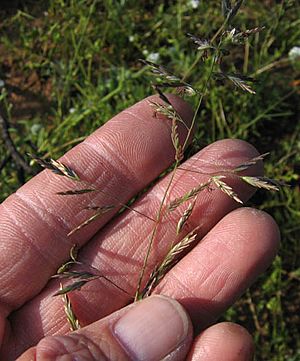Poa secunda facts for kids
Quick facts for kids Poa secunda |
|
|---|---|
 |
|
| Conservation status | |
| Scientific classification | |
| Genus: |
Poa
|
| Species: |
secunda
|
Poa secunda is a type of grass known by many names. Some common names are Sandberg bluegrass, alkali bluegrass, and Nevada bluegrass. It is a perennial bunchgrass, meaning it lives for many years and grows in clumps.
This grass is found all over North America and South America. It is very good at surviving dry conditions, like droughts.
Contents
Why Sandberg Bluegrass is Special
Sandberg bluegrass is very important for many reasons. It is excellent fodder, which means it provides good food for animals. Ranchers often use it to feed their livestock.
This tough grass also helps control soil erosion. Its roots hold the soil in place, stopping it from washing away. It is often planted to help land recover after forest fires.
Where This Grass Grows
Poa secunda is native to many parts of the Americas.
In North America, you can find it in Canada, especially in Alberta and British Columbia. It also grows across much of the U.S., including Alaska, California, Colorado, and Montana. You can even find it in northwestern Mexico.
In South America, this grass grows in central Chile and parts of Argentina. It is found in provinces like Chubut and Santa Cruz.
How People Use This Grass
Besides feeding animals and preventing erosion, Poa secunda has other uses. Some special types, called Cultivars, have been developed. These include 'Canbar', 'Service', and 'Sherman'.
Historically, Native Americans used this grass for food. For example, the Goshute people of Utah ate parts of P. secunda.
A Bit of History
The first scientific description of Poa secunda was in 1830. A botanist named Jan Svatopluk Presl described it. The original plant sample was collected in Chile in 1790 by Thaddäus Haenke.
See also
 In Spanish: Poa secunda para niños
In Spanish: Poa secunda para niños


